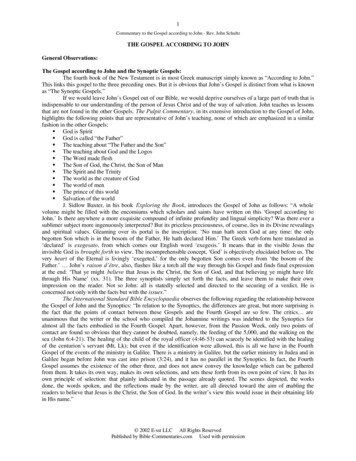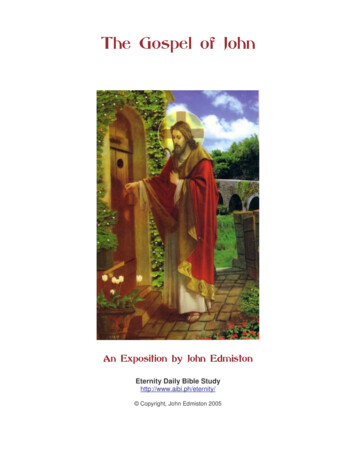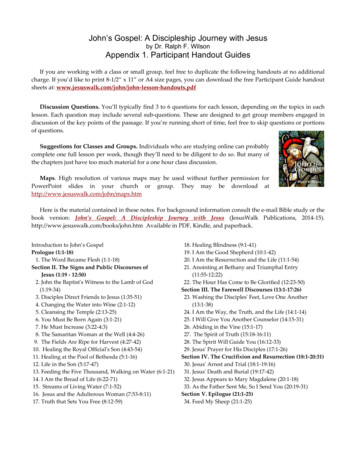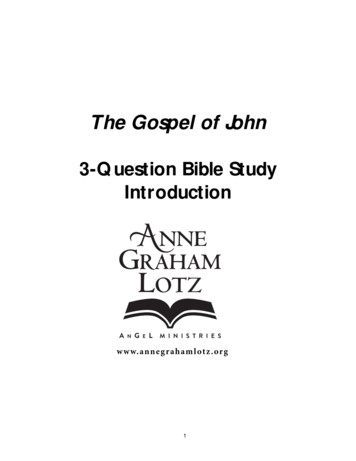
Transcription
LINE BY LINE BIBLE SERIESLine by line, verse by verse. These studies are designed tobring out the simple meaning of the biblical text for the modernreader.Copyright 2014 by Mike MazzalongoISBN: 978-0-9904155-4-1BibleTalk Books14998 E. RenoChoctaw, Oklahoma 73020
Scripture quotations taken from the New American Standard Bible ,Copyright 1960, 1962, 1963, 1968, 1971, 1972, 1973, 1975, 1977,1995 by The Lockman Foundation Used by permission.(www.Lockman.org)
CHAPTER 1:PROLOGUEJOHN 1:1-18The book of John is named after and attributed to John, theApostle. There is much internal and external evidence tosupport this and it has never been seriously contested so wewill not dwell on arguments concerning its authorship.We do have a good profile of John from the Scripture itself: Son of a wealthy fisherman (Zebedee) – Mark 1:20 Had a brother, James (not writer of the epistle)– Matthew 4:21-22 Close to Jesus, inner circle (Transfiguration) and it issaid Jesus loved him – Matthew 17; John 21 Zealous, impatient, intolerant – Luke 9:54 Jesus entrusted Mary to his care – John 19:26-27 Worked with Peter in Jerusalem – Acts 3We also have writers of the period referring to John in theirletters that give us more information about him. Polycarp,bishop of Smyrna reveals that: He made his home and work in Ephesus after thedestruction of Jerusalem in 70 AD, which was a keyinfluence on him and his writings. From here he wrote this gospel and three of hisepistles around 80 AD.
He was eventually exiled to the Isle of Patmos by theRoman emperor Domitian around 94-96 AD and fromhere he wrote the book of Revelation.Purpose of the gospel of JohnEach gospel writer had a purpose in writing their books: Matthew writes with the Jew in mind in order to showthat Jesus is the Messiah/King. Mark and Luke have the Gentiles in mind in order toshow that Jesus is the Redeemer that the nationslonged for. John wrote when the difference between Jew andGentile had disappeared (after the destruction ofJerusalem and the temple in 70 AD). He is writing fromAsia Minor where false doctrines such as Gnosticismare challenging the claims of Christianity and so hispurpose is to show Jesus as the Son of God and thatsalvation is found by faith in Him alone.This purpose is summarized in John 20:30-31.Therefore many other signs Jesus also performed inthe presence of the disciples, which are not written inthis book; but these have been written so that youmay believe that Jesus is the Christ, the Son of God;and that believing you may have life in His name. and developed throughout the book by using 3 mainthemes (think of braiding someone’s hair):1. Jesus is presented as a true man as well as the divineSon of God.2. The rise and development of belief.3. The rise and development of disbelief.
These themes are not presented in sequential order but rather,like three strands, they are braided together to form one singlenarrative.1 strand: He demonstrates Jesus’ humanity and divinity byalternately showing him as a man, doing human things (eating,weeping) and showing Him as divine (doing miracles).The other 2 strands: He interweaves the two other strands,belief and disbelief by describing how people reacted to Jesuswith faith or rejection as they witnessed His dual human/divinenature.John’s gospel describes the object of faith (Jesus Christ) andwhy He should be considered as such (miracles, resurrection).He also describes the development of belief or disbelief aspeople react to Him.OutlineWhen we understand this idea of braiding these three themesthe outline of the book makes sense.Prologue – 1:1-18In this opening section John introduces Jesus as the Son ofGod, the God/Man. He traces Jesus’ existence from the precreation era to His incarnation as a human being.Proof of His divinity through ministry– 1:19-12:50The next large section of the book simply braids together thetwo strands of episodes of belief and disbelief around thedescription of His ministry. John presents accounts of Histeachings and miracles with alternating responses of beliefand disbelief.
Proof of His divinity through His death, burialand resurrecQon – 13:1 – 21:25In the final chapters John uses the same technique ofdescribing alternating responses of belief and disbelief, butthis time they are set against the backdrop of His final days asHe is arrested, tried, tortured, crucified, buried andresurrected.John’s focus was quite narrow in this gospel. Jesus Himselfand who He was are presented along with a whole series ofbelieving and unbelieving responses from people around Him.The idea is that the reader will see not only Jesus, but will alsosee himself in the reaction of the various people.Prologue – 1:1-18So we begin our study with what is called the “prologue”because it is not a narrative about Jesus’ life or actions, butdescribes Him before coming to earth in human form.This is where John is different. He begins with a statementclearly declaring Jesus’ divine nature whereas the other threegospel writers allow the reader to conclude this from theevidence they present in their gospels.There was a certain concept of the idea of “word/logos” thatexisted at that time:For Jews: The Word/Logos (Greek) was a revelation fromGod. It was something to be understood and put into practiceas well as respected.For Gentiles/Greeks: Word represented the great “Reason”or “Power” or “Force” as we would say today. To be in accordwith this Word/Power was to have a happy and balanced life.John, in his prologue, explains that the full meaning of thisconcept is revealed through Christ: He is the Word, He is theLogos, He is the Force.
Vs. 1 – In the beginning This refers to the time before creation, that dimension thatexisted before the space/time continuum that we live in wascreated.John takes the reader to that point where one is standing atthe beginning of time and looking backwards into eternity. was the Word The “Word” is a title for Jesus. The Jews would see ‘revelationfrom God’. The Gentiles would read – ‘force/power.’ John uses“Word” for Jesus because what you say is a reflection of whatis in your heart and mind. This opening title for Jesusdescribes Him as being the perfect expression of the mind ofGod in human form. and the Word was with God, Not a power coming from God as in a created thing or anattribute of God. No, Jesus as person co-existing with God onan equal basis. In other words when God speaks, when thepower is realized, Jesus is what is said, what is expressed. and the Word was God.The Word was God/God was the Word.John, a devout Jew, would never say, “ and the Word was agod.” as the Jehovah’s Witnesses claim in their New Worldtranslations. This would violate his monotheistic belief, to himthis would be idolatry. And so in the 1st verse, John asks andanswers some basic questions: Who is the Word? God is the Word.
Why is the Word God? It is eternal (before time); itcoexists with God; its nature is divine.John, therefore, gives substance to this idea of Word/Logos,far beyond what the Jews or Gentiles had thought: The Word is Almighty God. God expresses Himself in the Word. God and the Word are one.Vs. 2 – He was in the beginning with God.Once having made the connection between God and theWord, John now begins to connect Jesus with the Word.He does not mention Him by name but uses the personalpronoun – He – to connect Jesus (who he will mention byname later) with the Word and ultimately to God.His reasoning is quite mathematical: If A (God) B (Word) And B (Word) C (Jesus) Then A (God) C (Jesus)So in the next verse he will complete this equation.Vs. 3 – All things came into being through Him, andapart from Him nothing came into being that hascome into being.The Jews attributed the creation to the power of God’s Word(“let there be light ” in Genesis 1:3). God literally spoke thecreation into existence. The Gentiles also saw the power of the“force” as the agent for creation.
In this verse John is connecting the Word to the person ofJesus, making Him and the Word as One. The idea is thatJesus, in the form of the Word, was the agent of creation. Thisteaching is also presented by Paul in Colossians 1:16: “For byHim all things were created, both in the heavens and onearth ”Vs. 4-5 – In Him was life, and the life was the Light ofmen. The Light shines in the darkness, and thedarkness did not comprehend it.Here John makes the bridge from divinity to humanity in threesteps:1. God is the Word in eternity.2. The Word is Jesus creating the universe.3. Jesus is the life bringing light into the world.John also summarizes Jesus’ earthly ministry: He is life (the essence of God). His life brings light (the truth of God). His Word does not disagree with anything true butreveals the final answer to all questions about God andsalvation, etc.John briefly explains at the beginning of his gospel whathappens at the end of his gospel: Jesus brings the truth and isrejected.Vs. 6-8 – There came a man sent from God, whosename was John. He came as a witness, to testifyabout the Light, so that all might believe through him.He was not the Light, but he came to testify about theLight.
In these verses John describes the role of one of the majorfigures in Christ’s ministry: John the Baptist. He will laterdescribe John’s work and connection to Jesus, but at this pointhe summarizes John’s purpose. John was a witness,according to Scripture, to prepare the people for the coming ofthe light/truth. The majority of John’s ministry was to alert thepeople that the Messiah was coming. In the end, after hebaptized Jesus, he began to directly point to the Lord as theOne who was to come. With his death, most of his disciplesbegan to follow Jesus.Vs. 9-11 – There was the true Light which, cominginto the world, enlightens every man. He was in theworld, and the world was made through Him, and theworld did not know Him. He came to His own, andthose who were His own did not receive Him.In this passage, John reviews and expands on what hementioned briefly in verse five. He makes three major points:1. He brought with Him and within Him the capability tobring every person into the knowledge of the truth(light).2. Even with this ability the world, which He created,rejected Him.3. The people (the Jews) that He had especially blessedwere especially hard and refused to accept Him.Vs. 12-13 – But as many as received Him, to them Hegave the right to become children of God, even tothose who believe in His name, who were born, not ofblood nor of the will of the flesh nor of the will of man,but of God.This is the gospel in capsule formIt does not explain everything in detail but rather gives a bird’seye view of what Jesus did accomplish with some. For those
who received (believed) Him, He transformed them intospiritual beings. Not created by normal reproductive means butby the will of God.The details are spelled out later, for now he merelysummarizes the fact that some rejected Him and othersaccepted Him. And for these, the blessing was to become anew creation he calls “child of God”.Vs. 14 – And the Word became flesh, and dweltamong us, and we saw His glory, glory as of the onlybegotten from the Father, full of grace and truth.The Word becoming flesh is the Incarnation. From God/Wordto Word/Jesus to Jesus/Man. Jesus the God/Man. In a fewwords John proclaims that Almighty God took on a humanbody.Now he speaks of his own experience of this. We (theApostles/John) saw (experienced) this glory (God/Man) – akind of glory that only the Son (God/Man) could radiate. Andthe substance of His glory (what it was about Him that madeHim glorious) was His Godly nature, grace and truth (the mindof God clearly expressed).The only begotten from the Father. Some never become sons of God. Others become sons by adoption as God forgives andcleanses them from sin and adopts them as Hischildren. Jesus, however, is a Son by nature. He is the only one(only begotten) related to God by having an identicalnature.John is also reminding his readers of the incredible “presence”that Jesus had, which makes the rejection of Him a terrible sin.
Vs. 15 – John testified about Him and cried out,saying, “This was He of whom I said, ‘He who comesafter me has a higher rank than I, for He existedbefore me.’”Reinforcing this idea of the impact of Jesus’ presence, thegospel writer reaches back and talks about John the Baptist’swork again. He says that even John the Baptist, in his witness,testified to the eternal quality and preeminent position of theOne who was to come. For example, “ the One to come wasbefore ” and John was conceived before Jesus. John theBaptist knew and preached about Jesus’ God/Man status.Again the implication is that their rejection was a grave sinbecause they had plenty of preparation of His coming from acredible source.Vs. 16 – For of His fullness we have all received, andgrace upon grace.Jesus is the Word and the Word is divine and for this reasonthe Word is completely full.You cannot exhaust the supply of truth and grace coming fromthe Word/Jesus/God just like you cannot use up the supply ofoxygen by breathing in the open air. You cannot exhaust theamount of grace and truth that Jesus/Word/God has towardssinners who breathe in God’s grace and truth through faith inJesus Christ.Vs. 17 – For the Law was given through Moses;grace and truth were realized through Jesus Christ.Moses received the Law (which contained the promise of thegrace and truth to come - Hebrews 10:1) and he administeredthis Law.
Jesus is the substance of the promises that were onlycontained in the Law. It is like the difference between having apicture of an item you have ordered from a catalogue or on theinternet and finally having the product in your hands.John speaks to Jews here by giving them a graphic illustrationto show them the difference between the Old Testament andthe New Testament. One is of promise (Old Testament) andone is of presence (New Testament).Vs. 18 – No one has seen God at any time; the onlybegotten God who is in the bosom of the Father, Hehas explained Him.No man has ever seen God. Moses spoke directly and saw theback of His glory. But Jesus, the God/Man, gives us anexperience of God not available until now. He is able to do thisbecause of His intimate knowledge of God, having the samenature and being part of the Godhead with Him. Jesus is ableto relate to man what He knows about God from firsthandexperience as a divine being within the Godhead Himself.SummaryJohn begins his gospel by establishing the fact that with hisown eyes he has experienced God taking on a human naturein order to give man an intimate experience and knowledge ofHimself. Since we could not transfer to His realm, Hetransferred to ours.This knowledge he calls “truth”/”light”. This experience he calls“life”. He says that for the most part, men rejected thisknowledge and experience. He also lists 3 witnesses thatproclaimed this knowledge/experience but were not believed: John the Baptist and his witness of preaching. Jesus Himself and His witness of miracles andteaching. John the Apostle and his eye witness.
With the prologue John sets up the three braids of his gospel.1. The presence of Jesus the God/Man.2. Reactions of belief.3. Reactions of disbelief.Beginning in verse 19, he will start to intertwine these threestrands to make up his gospel record.
CHAPTER 2:JOHN’S WITNESSJOHN 1:19:34We are studying the book of John and in this gospel Johnpresents three themes or strands which he intertwines tocreate a single narrative.1. The first strand is the presentation of Jesus as thedivine Son of God who has come in the flesh as JesusChrist. John establishes this theme immediately in thefirst 18 verses of his gospel, called the prologue. Hecalls Jesus the “Word” and explains that Jesus, thedivine Word, created the world and then entered Hisown creation as a man.2. The next strand is belief. John briefly mentions in hisprologue that some believed that Jesus was God andtheir belief led them to life and truth.3. The third strand is disbelief. In the prologue John alsomentions that even though Jesus provides proof/witnesses of His identity, His people and the majority ofothers do not believe.As I mentioned previously, John takes these three ideas andweaves them together to show Jesus in various situations:teaching, performing miracles (as proof of His divinity) and thereactions of belief and disbelief from those who witness thesethings.Once John has set forth the pattern for his gospel in chapter1:1-18, he begins with the introduction of a major New
Testament character, John the Baptist. John called him thisbecause this is what Jesus called him in Matthew 11:11.In the pattern of how the book is written, John serves as thefirst response of belief: John believes that Jesus is theMessiah and even begins to make a witness for it.John the Baptist was the second cousin of Jesus (Mary wasthe cousin of Elizabeth, who was John’s mother). Elizabethand Zacharias (his father) were very old and childless when anangel appeared to Zacharias while he ministered at the temple(he was a priest). This angel announced that Elizabeth wouldconceive a child and he would be named John.From an early age John the Baptist was set apart for a specialministry which, as he grew, was defined as one who preparedthe way for the Lord. This was in accordance with what theangel said about him and what the Old Testament said wouldhappen before the Messiah would come. According to theprophets (Malachi 3:1-3) God would send a messenger, aprophet in the spirit of or in the style of Elijah, to announce theimminent coming of God’s Messiah. John and his ministrywere the fulfillment of that prophecy and promise from God.And so John (the gospel writer) puts John (the Baptist) as thefirst example of one who believed. Jesus had not taught orperformed miracles before His baptism and so John’s faith andbelief in Jesus were based on a special sign that God wouldgive him so he could know who the true Messiah was. In John1:33, John the Baptist says that God revealed to him that theone over whose head a dove would appear after their baptism,this would be the one he was preparing a way for. This is oneof the reasons Jesus had to be baptized, to witness to John sohe could fulfill his mission. We know that this is exactly whathappened when Jesus was baptized as a signal to Johnamong others.John believed this sign and began to point to Jesus as theMessiah, the one for whom he was preparing a way.John the evangelist introduces John and his story as the firstexample of those who believed.
ReacQon of a believerSo we pick up the witness of the first believer, John the Baptistin chapter 1, verse 19.Vs. 19 – This is the testimony of John, when the Jewssent to him priests and Levites from Jerusalem to askhim, “Who are you?”The gospel writer introduces John the Baptist by telescopingdirectly to an encounter between him and the priests/Levites ofthe time concerning his true identity. The Baptist’s parents andconnection to Jesus’ family is detailed by Luke in his gospel,so John skips all of that and goes directly to an event in hispublic ministry.The “Jews” were the religious leaders (Pharisees). They werescribes who were zealous in keeping and enforcing the Law.Priests and Levites were those who ministered at the temple.John was drawing crowds, proclaiming the imminent coming ofGod’s kingdom, God’s Messiah and in doing so he was stirringup the people. The religious leaders, fearing the loss of theirposition or a backlash from the Roman authorities, sent adelegation to check out this preacher/prophet.In response to their question John makes his witness andconfession of belief in the One to come.Vs. 20-21 – And he confessed and did not deny, butconfessed, “I am not the Christ.” They asked him,“What then? Are you Elijah?” And he said, “I am not.”“Are you the Prophet?” And he answered, “No.”They ask him 3 questions:
1. They ask if He thinks He is the Messiah (because therewere many religious radicals that claimed this), and heanswers no.2. Are you Elijah? This was a reference to Malachi 4:5where the Old Testament prophet said that Elijah wouldreturn as a forerunner of the Messiah. Many Jewsbelieved that Malachi meant that God would actuallyresurrect Elijah and send him to the people. In Matthew11:14, Jesus explained that John the Baptist was theperson Malachi spoke of, that John the Baptist was aprophet in the “spirit” of Elijah: powerful preacher; manof the desert; man of vision. And so John, knowing theirconfusion, answers no, he is not the resurrected Elijah(even though he is the fulfillment of Malachi’sprophecy).3. Are you the prophet? In Deuteronomy 18:15 Mosessaid that one day God would raise up a prophet to leadthe people just as he (Moses) had led the people. Theywanted to know, did he think of himself as thatprophet? John answers no, he is not that prophet.Actually Jesus is that prophet. He is the fulfillment ofthat prophecy and promise (Acts 3:22-23 – Peter).Vs. 22 – Then they said to him, “Who are you, so thatwe may give an answer to those who sent us? Whatdo you say about yourself?”They have run out of questions and possibilities concerning hisidentity according to Scriptures. This was the key: who he wasaccording to prophecy. If not Christ, Elijah or the prophet, thenwho? The Pharisees wanted to know (probably so they couldplan an attack to discredit him).Vs. 23 – He said, “I am a voice of one crying in thewilderness, ‘Make straight the way of the Lord,’ asIsaiah the prophet said.”John answers that he is two things:
1. A voice. The significance is that he is a proclaimer andmessenger. In the wilderness refers that his is not apopular messenger and he is not part of theestablishment.2. One who makes straight. He challenges them. He goesagainst convention. He is here to prepare a new way(crooked was the old way).His ministry is spoken of by Isaiah, as this is whom he isquoting.Vs. 24 – Now they had been sent from thePharisees.”John adds an editorial comment in order to put their questionsand motives in context.Vs. 25 – They asked him, and said to him, “Why thenare you baptizing, if you are not the Christ, nor Elijah,nor the Prophet?”Their question shows their reaction to John the Baptist and hiswitness: they disbelieve. See the third strand being woven inhere?They are stung by his message because if he had said he wasChrist, they would accuse him of blasphemy or of being alunatic or an imposter. If he had said he was Elijah they wouldhave demanded proof through miracles, since Elijah didmiracles. If he had said he was the prophet they would havedenounced him as a troublemaker and reported him to theRomans.Instead he claims that his source for ministry was the prophetIsaiah who wrote extensively about the coming of the Messiahand the circumstances surrounding this event.
At this point they become defensive. They do not respond withbelief, instead they question his authority to baptize. If you arenot Elijah or the prophet, they say, what gives you the right tobaptize?When we are challenged with the truth, there are only 3 waysto respond:1. Become defensive. Get mad, run away, reject, deny.2. Rationalize. Give yourself good reasons to disbelieveor disobey.3. Submit. Listen carefully, obey the truth, do the rightthing.The reaction of the priests and Levites and by extension, thePharisees, was to become defensive and challenge John’sright to baptize, which in essence was a challenge andrejection of his message: “Get ready (by baptism) because theMessiah is coming.”Vs. 26-28 – John answered them saying, “I baptize inwater, but among you stands One whom you do notknow. It is He who comes after me, the thong ofwhose sandal I am not worthy to untie.” These thingstook place in Bethany beyond the Jordan, where Johnwas baptizing.John responds to their attitude rather than to their questionwhich was: “If you are not the Christ, Elijah or the prophet,what gives you the right to baptize? In essence he says:Yes I am baptizing, even though you think I have no right to doso because you do not believe my message. This is just likeyou. But, there is one here among you today that people likeyou do not know. You are threatened by what I say and do, butthe one of whom I speak is so great, I (who threaten you somuch) am not even worthy to untie His sandal. What will yousay and do when He comes?His reference to the Jordan situates the place where thisconfrontation took place and where John did much of his work.
In verses 29 to 34 the gospel writer now describes John theBaptist’s own witness about Jesus. This action takes placeafter Jesus’ baptism that is described in detail in the othergospels.His witness contains four elements:1. The purpose of Christ’s comingVs. 29 – The next day he saw Jesus coming to himand said, “Behold, the Lamb of God who takes awaythe sin of the world!”Jesus did not come to start a movement, do miracles, begin arevolution or a new philosophy. He came to die for men’s sins.Everything else serves this purpose or stems from it. Johncame to announce it; the Apostles reported it; we remember it.This is what faith is about: His death for us and what thatmeans.2. The character of the One to comeVs. 30 – This is He on behalf of whom I said, ‘Afterme comes a Man who has a higher rank than I, for Heexisted before me.’John was conceived before Jesus was, he was 6 monthsolder. By saying that Jesus was before him, he declares thatJesus has a divine nature, not simply a human one. We comeinto being when our bodies are conceived; Jesus existedbefore his body was conceived.3. The nature of his ministryVs. 31 – I did not recognize Him, but so that He mightbe manifested to Israel, I came baptizing in water.
His ministry was to baptize those who believed his preachingand wanted to prepare for the coming One. His ministry wouldbe validated because the One to come would also come firstthrough his ministry of baptism.4. The source of his ministryVs. 32-34 – John testified saying, “I have seen theSpirit descending as a dove out of heaven, and Heremained upon Him. I did not recognize Him, but Hewho sent me to baptize in water said to me, ‘He uponwhom you see the Spirit descending and remainingupon Him, this is the One who baptizes in the HolySpirit.’ I myself have seen, and have testified that thisis the Son of God.”John was recognized as special from his birth, peoplewondered how God would use him. In this passage he claimsthe authority of a prophet based on what he has received fromthe Lord. It has been 400 years since the last legitimateprophet spoke in Israel (Malachi) so this is quite a challengeand excitement for the people. However, it is not somethingnew: the Jews were familiar with the presence of inspired menspeaking from God.John says that God gave him his ministry and the sign toidentify the One for whom he was preparing the way. He saysthat the sign was the Spirit descending and remaining on oneindividual, this would be the One.In Matthew 3:16, Matthew describes the Spirit as a dovedescending on Jesus and a voice from heaven declaring HisSonship. This was the fulfillment of the sign John looked for.John was told that the one to whom this happened, this wouldbe the one who baptized with the Holy Spirit. In some casesthis meant to empower someone to do miraculous things. In allcases this meant the authority to send the Holy Spirit to dwellwithin a believer. John says that the fulfillment of this sign wasthe proof to him that Jesus was indeed the God/Man, the
Messiah. And so John acknowledges that he had a sign fromGod to direct him to the true Messiah and that sign was givenat the time of Jesus’ baptism.SummaryWe have our first episode where John entwines all three of histhemes.1. Jesus the God/Man. John explains the supernaturalway John the Baptist was alerted to Jesus’ coming.2. Disbelief. The first examples are the Pharisees, priestsand Levites who challenge John’s authority to baptizewhich indirectly disregarded his message (whichrequired him to baptize).3. Belief. John the Baptist himself was the first truebeliever and we see him explaining the things (signs)that led him to belief.And so in his description of John the Baptist’s ministry, Johnsets forth yet another claim of Jesus’ divine nature andprovides two reactions to this claim (the challenge by theJews) as well as the belief and witness of John the Baptist.
CHAPTER 3:THE PATTERNOF WITNESSJOHN 1:35-51We are studying John’s gospel and John’s presentation ofJesus as both fully man and fully God. He makes thispresentation by using three different strands of narratives:1. The first strand is made up of accounts of Jesus’ministry and miracles that show both His divine natureand human nature.2. The second strand contains stories of how somepeople react to Jesus with faith and trust.3. The third strand contains other stories that showpeople reacting to Him with disbelief and rejection.John does not recount these events in the order I have justexplained them. Instead he weaves the three strands into asingle narrative with each strand coming into view from time totime.So far we have seen John begin with a statement thatpresents Jesus as the divine Messiah and how some wouldbelieve and others would disbelieve this claim. This section isin chapter 1:1-18 and is called the prologue. In these 18verses John summarizes his entire gospel and alsodemonstrates the three strand approach he will use in writinghis information.
After the prologue we looked at John the Baptist, the firstcharacter introduced by the gospel writer. As far as the gospeland its approach are concerned, John the Baptist is the firstexample of someone who believed.In our last chapter we examined John’s witness of faith and hisrole in preparing the way for Jesus the God/Man’s coming.Witness – BackgroundLet’s leave off our main framework of study (the three strandsmade up of Jesus’ wit
Purpose of the gospel of John Each gospel writer had a purpose in writing their books: Matthew writes with the Jew in mind in order to show that Jesus is the Messiah/King. Mark and Luke have the Gentiles in mind in order to show that Jesus is the Redeemer that the nations longed for. John wrote when the difference between Jew and
